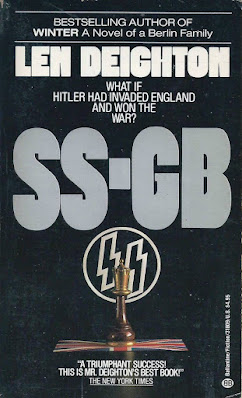May is 'Third Reich Triumphant' Month at the PorPor Books Blog
Book Review: 'Hitler Victorious' edited by Gregory Benford and Martin H. Greenberg
3 / 5 Stars
'Hitler Victorious' (278 pp.) was published as a hardcover by Garland Publishing in 1986. Some of the contents previously were published, while others were commissioned especially for the anthology.
In his Preface, Benford alludes to Einstein's concept of the gedanken, or 'thought experiment,' and its history in both general and sci-fi literature as a vehicle for asking 'what if.'
Norman Spinrad, in his Introduction, examines the allure the idea of a victorious Third Reich has on science fiction writers. As far as Spinrad is concerned, there is something decidedly psychosexual to it all (?!):
Thus the forthrightly phallic Nazi salute, the tight black uniforms of the SS, the silver death's heads,the twin lightning bolts, the barbarian torchlit splendor, the stirring martial music, the 'SS Werewolf Division,' the whole obsessive and twisted Satanism of the Nazi symbol systems, as the supermen in their chrome-and-black S & M gear thrust their right arms erect and, with their assholes tight and fire gleaming in their eyes, march off to bugger the world.
Well...........! Who woulda thunk it ?! Anyways, below are my capsule summaries of the contents:
Two Dooms, by C. M. Kornbluth (1958): it's May, 1945, and in New Mexico, physicist Edward Royland is laboring on the Manhattan Project. He decides to partake in a 'sacred plant' ceremony in the hut of the Indian shaman Nahataspe, and blacks out. When he wakes up, Royland is 150 years in the future, in an America divided in two, shared between Imperial Japan and the Nazis.
This novelette apparently was a posthumously published draft, and while it has some striking imagery and some intriguing extrapolations, it suffers from Kornbluth's overly wordy prose style, and his insistence on larding said prose with all sorts of cutesy wordsmithings designed to let us know what a clever fellow he, Kornbluth, is.........
The Fall of Frenchy Steiner, by Hilary Bailey (1964): it's 1955, and the UK has been conquered by the Third Reich. The first-person narrator, Sebastian, is a folk singer in a shabby bar; a disheveled young woman named Frenchy likes to come by every now and and then, and sing accompaniment. When Frenchy gets in a spot of trouble, against his better judgment, Sebastian decides to help her.
This is one of the better entries in the anthology. Bailey's depiction of a Britain under Nazi subjugation has a memorably bleak quality. The second half of the novelette goes off in an unexpected, but imaginative, direction, with an ending that features notes of dark humor.
Through Road No Wither, by Greg Bear (1985): two Nazis enjoying the Reich victorious in 1979, make a fateful detour while traveling on a dark and foggy night in France. It's a little too opaque to be very rewarding.
Weihnachtsabend, by Keith Roberts (1972): the title is 'Christmas Eve' in German. In a 1960s UK subservient to Nazi Germany, a bureaucrat named Mainwaring, on holiday in a country estate, confronts the true reality of the Reich.
Over the decades I've become familiar with Roberts's inferential style of writing, where the attention is placed more on atmosphere, setting, and characterization, while plot developments are alluded to in an elliptical manner. So I found this story rewarding, if needing more attention than I usually am wont to give.
Thor Meets Captain America (1986), by David Brin: it's 1962, and the Allies are losing the war against the Reich. A desperate commando mission is undertaken, its goal to strike a decisive blow against the Nazis. And Loki, the trickster god, is along for the ride ?! Of all the stories in 'Hitler Victorious,' this one comes closest to displaying the wacky energy of the modern-day 'Wolfenstein' franchise of video games.
Moon of Ice (1986), by Brad Lineweaver: it's April, 1965, and Joseph Goebbels is in a retrospective mood. The Third Reich is triumphant in Europe, but the recent passing of Adolf Hitler signals the end of the era. And the rise of a resistance......
This novelette starts off on an interesting enough note, but at its halfway point, transitions into pulp / comic book escapades involving super mutants, mad scientists, conspiracies, genetic engineering, etc. It's too contrived to be effective.
Reichs-Peace (1986), by Sheila Finch: it's the 1980s and a young woman named Greta learns that she is very, very important to the Reich and its continued rule. This novelette seeks to humanize some of those Germans who flourished during Hitler's regime.
Never Meet Again (1957), by Algis Budrys: it's April, 1958, and Europe is ruled by the Third Reich. Professor Klempfer is pondering a way to escape to another reality.....maybe one where the Nazis lost ?
Do Ye Hear the Children Weeping ? (1986), by Howard Goldsmith: a young American couple rent a house in Munich. A house with a very troubling background. This is more of a horror story than science fiction.
Enemy Transmissions (1986), by Tom Shippey: in a 1985 UK under the rule of the Third Reich, Richard Grenville is recruited for some very unusual experiments involving dreams, and messages from alternate realities.
Valhalla (1986), by Gregory Benford: it's April, 1945, and in the Fuhrerbunker, in the ruins of Berlin, Adolf Hitler and Eva Braun are preparing to commit suicide. Suddenly, a strange blue glow appears inside the bunker........
Summing up, 'Hitler Victorious' comes away with a Three-Star Rating. At the time of its commission, the pool of stories that could qualify as tales of a triumphant Third Reich was small and necessarily placed some constraints on the editors.
At the same time, however, the fact that the bulk of the entries in this anthology were written in 1986 suggests that the editors could have, but didn't, look to solicit more contributions from the cyberpunks. I have to believe that (apart from Greg Bear) Gibson, Sterling, Shirley, Dozois, and Swanwick could have done better with the theme than most of contemporary contributors. In that regard, 'Hitler Victorious' represents something of a missed opportunity in the catalog of 1980s sci-fi anthologies........







































































